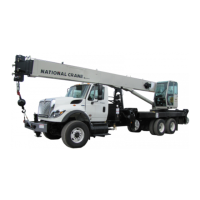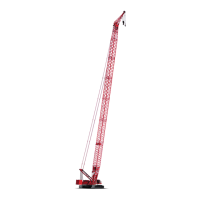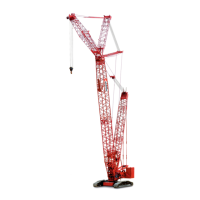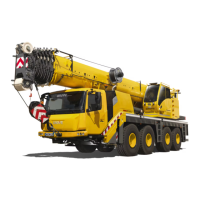National Crane 1-21-2019 Control # 104-07 1-5
1400A SERVICE MANUAL INTRODUCTION
Bearings
Antifriction Bearings
When an antifriction bearing is removed, cover it to keep out
dirt and abrasives. Wash bearings in non-flammable
cleaning solution and allow them to drain dry. The bearing
may be dried with compressed air BUT do not spin the
bearing. Discard the bearings if the races and balls or rollers
are pitted, scored, or burned. If the bearing is serviceable,
coat it with oil and wrap it in clean waxed paper. Do not
unwrap new bearings until time of installation. The life of an
antifriction bearing is shortened if not properly lubricated. Dirt
can cause an anitfriction bearing to lock and result in the
shaft turning in the inner race or the outer race turning within
the cage.
Double Row, Tapered Roller
Double row, tapered roller bearings are precision fit during
manufacture and components are not interchangeable. The
cups, cones, and spacers are etched with the same serial
number and letter designator. If no letter designators are
found, wire the components together to assure correct
installation. Reusable bearing components should be
installed in their original positions.
Heating Bearings
Bearings which require expansion for installation should be
heated in oil not to exceed 121 °C (250 °F). When more than
one part is heated to aid in assembly, they must be allowed
to cool and then pressed together again. Parts often
separate as they cool and contract.
Installation
Lubricate new or used bearings before installation. Bearings
that are to be preloaded must have a film of oil over the entire
assembly to obtain accurate preloading. When installing a
bearing, spacer, or washer against a shoulder on a shaft, be
sure the chamfered side is toward the shoulder.
When bearings are pressed into a retainer or bore, apply
pressure to the outer race uniformly. If the bearing is pressed
on the shaft, apply pressure on the inner race uniformly.
Preload
Preload is an initial load placed on the bearing at the time of
assembly. Consult the disassembly and assembly
instructions to determine if the bearing can be preloaded.
Be careful in applying preload to bearings requiring end
clearance. Otherwise, bearing failure may result.
Sleeve Bearings
Do not install sleeve bearings with a hammer. Use a press
and be sure to apply the pressure directly in line with the
bore. If it is necessary to drive on a bearing, use a bearing
driver or a bar with a smooth flat end. If a sleeve bearing has
an oil hole, align it with the oil hole in the mating part.
Gaskets
Be sure the holes in the gaskets correspond with the
lubricant passages in the mating parts. If it is necessary to
make gaskets, select material of the proper type and
thickness. Be sure to cut holes in the right places. Blank
gaskets can cause serious damage.
Hydraulic Systems
Visual Inspection
Do a visual inspection daily on all hydraulic components for
missing hose clamps, shields, guards, excessive dirt build
up, and leaks. Do a monthly or 250 hour inspection for the
items listed in the inspection procedure below.
Valves and Manifolds
Inspect valves and manifolds for leaking ports or sections.
Hoses and Fittings
Inspect all hoses and fittings for the following:
• Cut, kinked, crushed, flattened, or twisted hoses.
• Leaking hoses or fittings.
• Cracked, blistered, or hoses charred by heat.
• Damaged or corroded fittings.
• Fitting slippage on hoses.
If any the above conditions exist, evaluate and replace as
necessary.
The climate in which the crane operates affects the service
life of the hydraulic components. The climate zones are
defined in the table on page 1-6. Recommended
replacement of hoses is as follows:
• Climate zone C after 8,000 hours of service.
• Climate zones A and C with high ambient temperatures
and duty cycles after 4,000 to 5,000 hours of service.
• Climate zones D and E after 4,000 to 5,000 hours of
service.
Cleanliness
Contaminants in a hydraulic system affects operation and
results in serious damage to the system components.
DANGER
Pressurized hydraulic fluid can cause serious injury.
Depressurize the hydraulic system before loosening
fittings.
Fo
r
Reference
Only

